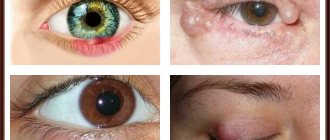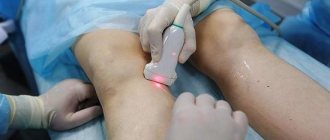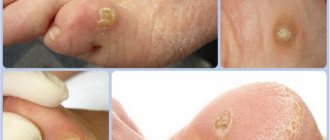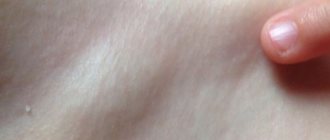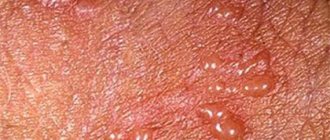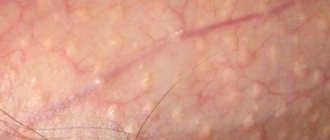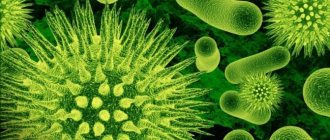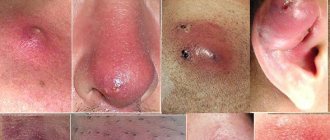A lump under the chin appears unexpectedly. Compaction occurs in people of different ages and genders. Patients immediately panic, not understanding what it could be. Some people think of cancer as a terminal illness.
But don't worry too much. Most often, a tumor under the chin is benign and can be easily treated.
If you consult a doctor in a timely manner, you can avoid unpleasant consequences, and recovery will come faster.
Causes
The main factors provoking the development of the disease are the following.
- Dental pathological changes in hard tissues - caries that is not treated in a timely manner can lead to the spread of infection to the periodontium through the root canals. When pathogenic microorganisms enter soft tissues, they provoke the occurrence of pathological formations. This group of factors also includes doctors’ mistakes, made, for example, when filling damaged tooth canals.
- The development of inflammatory processes in surrounding organs - gum disease, sinusitis, etc. During inflammation, infectious agents quickly penetrate into the bone tissue from the nasal and maxillary sinuses. If the patient has low immunity, the infection can spread even from those foci of inflammation that are remote from the oral cavity.
- Injuries of a traumatic nature do not appear clinically at first. A cavity of a pathological nature can arise from attempts to gnaw nuts, open bottles with teeth, a fracture, a bruise, a blow, constant exposure to a prosthesis or an unsharpened edge of a dental crown.
- The rarest factor in the occurrence of a dental cyst in the lower jaw is a developmental defect, a congenital anomaly.
Symptoms
A mandibular cyst may not manifest clinical symptoms for a long time. Signs of pathology become noticeable with increasing formation, development of the inflammatory process, and deterioration of the condition. The main signs of a cyst are:
- the appearance of pain;
- redness of the gums;
- the occurrence of swelling in soft tissues;
- formation of purulent accumulations;
- increased body temperature;
- the appearance of general symptoms of malaise - weakness, fatigue, headache, drowsiness;
- deformation of the jaw bones;
- swelling of the jaw;
- the appearance of sinusitis, exacerbation of its symptoms.
Symptoms of a mandibular cyst should not go unnoticed.
Types of jaw cysts
Clinically, the pathology manifests itself differently depending on what shape the formation has, how widespread it is, what its size is, and what the causes of infection are. Cysts of the lower jaw are usually classified as follows.
- Primary (primordial) cyst. Another name for such a formation is keratocyst. This type of cyst is a pathological growth of the eighth molar (wisdom tooth). The cyst can be single-chamber or multi-chamber; even after its removal, relapses can develop. Inside the formation there is not only purulent contents, but also crumbs of hard tissue.
- Radicular cyst of the mandible. This form of neoplasm occurs most often and is diagnosed in 80% of all cases. It is often found on the upper jaw, but it can also be located on the lower jaw. The process of cyst formation begins with a protracted inflammatory process in the soft tissues located near the tooth. Under the influence of the body's defenses, a capsule of fibrous tissue is formed around the source of inflammation. As a result, the formation stops spreading to nearby tissues, and purulent contents begin to accumulate inside it. Over time, the cyst produces network-like processes that grow into the surrounding tissue. Such growth, as a rule, leads to the degeneration of the cyst into a malignant tumor located in the jaw bone. This specific development is typical only for radicular cysts of the lower jaw.
- Retromolar. Develops as a result of prolonged chronic inflammation, which arose as a response to complex eruption. Quite often, a retromolar cyst is localized in the area of the eighth molars, which are characterized by such difficulties.
- Nonodontogenic (nasoalveolar) cyst. It is located in the palato-nasal canal, above the front incisors on the upper jaw. Outwardly it looks like a hilar cyst, but has certain features due to its location.
- Follicular cyst of the mandible. It is a formation similar to a tooth that has not yet erupted. Inside the cyst there may be a rudiment or an already formed tooth.
- Aneurysmal cyst. A rare type of formation affecting the lower jaw. There is blood or reddish fluid inside the cyst. The only reason that provokes the development of such a cyst is hormonal disorders, including those accompanying puberty. Over time, the cyst grows, causing deformation of the jaw bones.
- Traumatic. Occurs as a result of mechanical trauma, unsuccessful use of dental instruments, or impact. A cyst may not manifest itself with clinical symptoms, so it is usually discovered during a routine examination.
- Residual. It occurs as a result of unsuccessful tooth extraction and can be a complication after surgery.
Odontogenic and non-odontogenic
Most often, the epithelial layer inside the formation is destroyed. Therefore, experts divide all cysts into odontogenic and non-odontogenic. The former develop as a result of pathologies of bone tissue, the latter do not relate to the gums and teeth and arise as a result of the development of the process of inflammation in the facial bones. Nonodontogenic cysts often develop in newborns; a genetic disorder is a factor in their occurrence.
There are other types of cystic formations, for example, an epidermoid cyst in the oral cavity. However, despite the fact that such a cyst is located in the jaw area, it is a skin disease and does not affect bone tissue.
In what cases is removal of a mandibular tooth cyst indicated?
Seal on the joint
Joint balls on the fingers are a hygroma, a type of cyst of growing joint tendon tissue.
A synovyl cyst usually grows in the form of a soft, smooth ball, inside it is filled with fluid like dense jelly. The reasons for their appearance are called aging or damage to joints and tendons.
When a hygroma on a joint does not bother a person, it can be left. But what if it causes pain and inconvenience at work? You should go to the doctor to have it removed. Articular hygroma has a big drawback - after removal, it can grow again in the same place.
We suggest you read: How many days does your gum hurt after dental implantation?
Therapy
In cases where the formation is small in size (up to 3 mm), it is called granuloma. For some time, such formations should be under the supervision of a doctor. Treatment of a mandibular cyst is indicated only if the granuloma begins to increase in size. The main methods of treating cystic formations are the following.
- Therapeutic manipulations. Specialists prescribe rinsing of the root canals, into which medications are then injected, and tissue cementation. Under the influence of drugs, the cystic formation thickens and is neutralized. Therapeutic treatment can only be used in cases where the cyst has a radicular shape and a size of no more than 0.8 cm.
- All other methods involve surgery. Cystectomy is an operation to remove the infectious focus and adjacent tissues that have been affected.
- Cystotomy is the most popular method of removing a mandibular cyst, which allows you to save the tooth. With cystomy, the anterior wall of the tumor is removed and all pathological contents are scraped out.
- Plastic cystectomy is a procedure similar to simple cystectomy. The main difference is that the soft tissues are not sutured after removal of the tumor. This method of surgical intervention is used, as a rule, in advanced conditions accompanied by complications.
- Two-phase surgery for mandibular cyst. It is a more complex procedure, which is prescribed exclusively in the most difficult cases. During the operation, the surgeon tries to preserve intact teeth and tissues as much as possible, while removing the infectious focus. A two-phase operation includes cystectomy and cystomy, which are performed in a specific order.
- Removal of the cyst along with the tooth. This method is used mainly when the cyst is localized in the area of the eighth molar.
- If the pathology leads to the development of osteomyelitis, the patient is shown a more serious intervention, in which the infected area is opened and the destroyed tissue and pus are carefully scraped out.
Complications
When a question arises about the need for treatment of cystic formations, it should be taken into account that pathology can provoke the development of serious complications, including:
- loss of teeth;
- the occurrence of fistulas;
- development of osteomyelitis;
- degeneration of formations into malignant tumors;
- the appearance of purulent formations;
- the appearance of phlegmon on the neck, face;
- jaw fractures;
- inflammatory process in the periosteum;
- loosening of healthy teeth located in close proximity to the infectious source.
Prevention of pathology development
The development of pathology can be prevented by following certain preventive rules:
- It is important to brush your teeth thoroughly every day;
- You should periodically have your teeth professionally cleaned to remove tartar and plaque;
- You must contact your dentist promptly if any unpleasant symptoms or pain occur;
- preventive examinations at the dentist, carried out twice a year, will detect pathological changes at the earliest stages of development;
- It is important to follow nutritional rules, eat a variety of foods rich in various vitamins, minerals, containing large amounts of fluorine and calcium.
It should be remembered that only timely diagnosis of the disease and therapy in accordance with the recommendations of a specialist will prevent the development of undesirable consequences.
A lump of swelling under the chin that appears suddenly indicates compaction of the epidermal tissues or excessive accumulation of fatty tissue. If a dense nodular lump has formed around the chin, this does not necessarily mean that the nature of the origin of this neoplasm is necessarily malignant. It is quite possible that the tumor is benign and developed under the influence of certain pathogenic factors present in a person’s life. With timely treatment, the occurrence of a full-fledged cancer tumor can be avoided.
What could it be - the causes of a tumor on the chin
If the development of a tumor under the chin occurred suddenly, then this is not a reason to sound the alarm. Most likely, this is a peculiar manifestation of local inflammation and an internal pimple with a purulent pustule has formed in the subcutaneous layer, formed as a result of penetration of a pathogenic infection into the skin. Also, the appearance of a lump under the chin that resembles a tumor may be due to the following reasons.
Popularly, a lump of this nature of origin is called a wen. This is a truly benign neoplasm, which consists of excess accumulation of fat in the subcutaneous layer. Due to the fact that fatty tissue accumulates in the same segment of the epithelial cover, a compaction is formed and the fat clot resembles a tumor body. Lipoma is practically unable to transform into a malignant formation, therefore it is considered safe for the human body. Most of all, it brings aesthetic and psychological discomfort. The danger comes from the wen, which has begun to turn red, inflamed and painful. This is a clear sign of the development of a pathological condition of adipose tissue and surrounding tissues of the epidermis.
This is inflammation of the hair follicle. In women, this disease is rare, but is still periodically diagnosed in medical practice. Ladies who have excess hair in the chin area are susceptible to the disease. As a rule, women aged 45 years or more are at risk. Hormonal changes in the body lead to the fact that even the smallest hair follicles cease to receive the required amount of nutrients and this leads to their inflammation as a result of the pathological process in the follicle.
Where the hair follicle is located, sanguineous fluid and purulent contents begin to accumulate. These biological fluids form a kind of pustule, which upon palpation resembles a tumor. The formation is dangerous because inflammation and swelling of tissues can spread to the larynx area and affect the respiratory tract. If, in addition, a bacterial infection of the inflamed follicle occurs, the consequences for the patient’s health can be very sad, and the treatment can be lengthy using potent antibacterial drugs.
It is a benign sebaceous gland cyst located in close proximity to the chin. Atheroma is formed under the influence of excessive synthesis of sebum by the glands, which, when functioning stable, should secrete just enough secretion to ensure sufficient hydration of the skin of the neck around the chin. If the sebaceous gland begins to produce too much sebum, the skin pores become clogged and fat begins to accumulate in the subcutaneous layer, forming a cyst.
In fact, this is one of the types of wen, but the nature of the formation of this tumor is slightly different from how a lipoma is formed.
In dermatology, this neoplasm is called an epidermal cyst. It occurs in the chin area due to metabolic disorders in epithelial cells. In the future, this leads to the appearance of small voids in the surface layer of the skin. This is considered a deviation from the normal state of the skin and the body fills the voids with keratinized particles of the epidermis, which in their structure resemble fibrous tissue. As a result of this, a dense knot is formed under the chin, which, upon palpation and visual inspection, in all its characteristics resembles a dense lump. Quite often, a skin cyst has a bluish tint, which is associated with an effect on the smallest vessels, capillaries, and a violation of the venous outflow of blood in this part of the body.
The most terrible and dangerous diagnosis, indicating the development of an oncological process in a person. This reason for the presence of a lump in the chin area is provoked by negative factors present in the patient’s life, which provoked the degeneration of previously healthy epithelial cells and the formation of a tumor. If treatment was started at stages 1-2 of cancer development, then the prognosis for recovery is quite high. At later stages, the process of metastasis begins and, at first glance, a very harmless chic produces millions of malignant cells into the blood, capable of forming similar tumors in any part of the sick person’s body.
If pyogenic microbes enter the skin in the chin area, acute inflammation of the deep epidermal tissues occurs. As a result of this, the patient observes a rapidly increasing lump under the chin, which is painful, swollen, and the surface of the skin has a red and inflamed appearance. Most often, a lump under the chin of this nature occurs as a complication after suffering a sore throat with bacterial damage to the mucous membrane of the throat due to a streptococcal infection, or the presence of chronic tonsillitis in the patient.
The latter disease in most cases is provoked by invasion of the tonsils by a strain of Staphylococcus aureus. This biological agent very often affects epithelial cells in the area of its localization. As the purulent contents mature, the lump in the form of an abscess becomes soft and if it has not been surgically removed, the skin is able to cleanse itself by breaking through the infectious tumor with the release of purulent contents.
Other causes of acne and bumps on the chin
Poll: When did your acne appear? (Number of votes: 4295)
I've been suffering all my life
It's been a couple of years now
About a few months
Recently
To vote, click on the desired answer. results
The appearance of bumpy acne on the chin can be caused by suddenly stopping the use of birth control pills, due to which hormonal changes in the body can lead to the appearance of spots and bumps on the chin.
Excessive sweating causes subcutaneous sebum to clog pores and cause acne on the chin.
A poor diet consisting of foods low in vitamins and nutrients can also lead to acne breakouts.
Smokers are more vulnerable to sudden changes in skin condition and the appearance of acne in the form of bumps and spots on the chin.
Very rarely, infections such as rosacea, discoid erythematous lupus, warts, facial dermatomycosis, abscess, insect bites, herpes, boils, moles, melanoma, actinic keratosis, perioral dermatitis, and some other infections can also cause pimples, spots or bumps on your chin.
Treatment - what to do with a lump on the chin under the skin that hurts?
The first thing a patient should do if he discovers a nodular tissue compaction resembling a tumor on his chin or under it is to contact a medical institution at his place of residence, or the nearest clinic. It all depends on the general well-being of the person. Therapy for the neoplasm is based on the presence of which particular disease caused the formation of a lump in the subcutaneous layer. Treatment may include the following procedures:
The presence of a purulent pustule inside the lump, formed as a result of the formation of an infectious abscess, requires the use of antibacterial drugs that suppress the activity of the bacterial pathogen. Tablets and intramuscular antibiotics are used in the form of injections. The type of drug is determined solely by the attending physician, based on what type of infection was detected during laboratory testing. As the bacterial population decreases, inflammation goes away, and the lump acquires a soft structure and gradually resolves.
In some cases, patients with a lump in the chin area are shown electrophoresis to warm up areas of the skin in order to speed up blood circulation in the epithelial tissues and prevent the re-formation of a benign tumor. As a rule, this element of therapy is used in the treatment of epidermal cysts.
A universal and conservative method of treating tumors of all types formed in the chin area. Surgical intervention involves performing a local strip operation with dissection of the skin and mechanical removal of wen, abscesses, cysts and other foreign formations that were found in the surface layer of the epithelium. The method is really effective and allows you to avoid relapses of the disease, but it traumatizes the skin, and the healing time for the suture can be from 2 to 3 weeks.
If a patient is diagnosed with a malignant tumor under the chin, which really threatens his life, doctors develop a comprehensive therapeutic protocol, which includes surgical removal, radio wave irradiation and physiotherapy. A key element in the course of treatment is the use of chemicals that kill cancer cells and reduce the size of the tumor. They also do not allow the malignant neoplasm to spread its metastases throughout the body.
The disadvantage of chemotherapy is that the toxic substances contained in drugs in this category kill not only cancer cells, but also destroy healthy tissue of vital human organs. Therefore, cancer patients feel very bad after undergoing another course of chemotherapy. Treatment with cytostatic drugs allows for a targeted effect on tumor cells without harming other tissues. Cytostatics are new generation drugs that allow you to remove a malignant lump under the chin without harming the overall health of the body.
The most common pathologies causing pain under the chin
Inflammation of the lymph nodes
A phenomenon that is most often diagnosed in patients. It is noteworthy that this pathology can be identified independently. Firstly, the type of pain is somewhat different from others. This is something adjacent between the sensations during a sore throat and pain during external inflammation. Discomfort is felt both outside and inside. For example, with an inflamed lymph node, a sharp turn of the head may be accompanied by severe pain. Swallowing causes approximately the same sensations.
Inflammation can be detected physically. Just feel lightly for the source of the pain. There will be a small bump located just under the skin. This is a mobile inflammation, so it can be easily distinguished from external formations. Sensations during physical contact can only be confused with a lipoma. But it is noteworthy that this type of inflammation almost never occurs on the neck. This is due to the minimal thickness of adipose tissue in this part of the body.
Considering that this is the most common cause of pain in the neck, well-known doctors often give recommendations for improving the condition. Watch an excerpt from a themed popular TV program:
Skin formations
In this case, the tumor develops and increases in size much faster. Within a few days after the first signal, a clearly identified source of pain will most likely appear. At this stage of development, it will be somewhat more difficult to treat the formation. Therefore, doctors recommend seeking help as soon as you feel discomfort in the lower part of your chin.
Don't be afraid that you might choose the wrong doctor in the first place. This is fine. After the first examination, the dermatologist will simply refer you to the right specialist if the pathology is not related to the skin itself. The main thing is that the examination is carried out quickly and efficiently.
If your chin suddenly begins to hurt from below without any preliminary symptoms, go to the hospital immediately. The fact is that this may be a sign of the emergence and development of a malignant tumor in the skin. Do not try to diagnose the pathology yourself and, especially, apply any treatment methods. This will only prolong time and, even worse, may lead to more negative consequences.
Physical damage
The skin and muscles under the chin are very sensitive. Consequently, any physical contact can lead to severe pain. Moreover, the injury can be long-term, so the pain will not go away for quite a long time. To get rid of it, you need to see a doctor, accurately determine the cause of the discomfort and neutralize the source.
Any bruise can lead to soft tissue damage. As a result, a hematoma forms under the chin, which provokes pain. Traumatic injury to soft tissue is considered the easiest, since the bones in this case are intact, and the bruised muscle recovers quite quickly. Moreover, the process can be accelerated by using specialized medications prescribed by your doctor. The pain is noticeably subsiding every day, as are the visible consequences of the damage.
There may also be mild swelling of the chin, which may make chewing difficult. As a rule, within a day of injury, the swelling completely disappears. But, if you have severely damaged the muscle itself, it may be present as long as the hematoma itself. Here you can only speed up the treatment process itself by using the right medications.
Infectious diseases
If the pathology in your body is caused by an infection, and at the same time your chin hurts, most likely a purulent formation has appeared here. Such inflammations are dangerous on any area of the skin, but especially on the chin, since there is a possibility of breathing problems. Any cellulitis, boils, carbuncles or abscesses should be treated immediately. The more you delay, the more dangerous inflammation poses to your body. In some cases, ignoring the need for treatment can be fatal.
The problem is that at the first stage of development, pain occurs only upon physical contact with inflammation. If you accidentally pressed on it and feel pain, contact a specialist immediately.
Despite the large number of causes of pain under the chin and their varying degrees of severity, in any case you need to be examined by a dermatologist. This will, at a minimum, help you protect yourself from life-threatening infections.
A lump under the chin appears unexpectedly. Compaction occurs in people of different ages and genders. Patients immediately panic, not understanding what it could be. Some people think of cancer as a terminal illness.
But don't worry too much. Most often, a tumor under the chin is benign and can be easily treated.
If you consult a doctor in a timely manner, you can avoid unpleasant consequences, and recovery will come faster.
Possible complications if the lump is not treated, which doctor should I contact?
If you find a lump under your chin, this tumor cannot be ignored. You should immediately seek help from a surgeon. Foreign external and subcutaneous formations, regardless of their nature of origin, are the domain of a specialist in the field of surgery. The doctor will conduct a visual examination of the tumor, palpate it, and then write a referral for tests. Having received data on the patient’s health condition, the doctor will be able to prescribe appropriate treatment. In the absence of proper therapy, complications such as:
- inflammatory swelling of the larynx with the onset of suffocation;
- sepsis caused by infection in the blood, lymph and bone marrow;
- development of the tumor up to stage 4 with the spread of metastases throughout the body and imminent death;
- compression of blood vessels with disruption of local circulation.
There are many options for complications of the clinical picture of the disease, depending on the etiology of the lump and how long it has been present in the subcutaneous layer of the chin area.
The appearance of swelling in the facial area is not only a cosmetic defect, but also a symptom of a malfunction in the body. A lump on the chin occurs due to various reasons and provoking factors. Often patients panic, believing that it is an oncological tumor. This possibility exists, but the tumor also appears due to another etiology that is not related to cancer processes in the body. Let's consider why swelling appears on the skin and what it could be?
- Lump under the chin
- Why did a lump appear on the neck under the chin?
- The first signs of cancer and benign tumors
- Lipoma
- Folliculitis
- Malignant tumor
- Skin cyst
- Atheroma
- Who should I contact if I have a lump under my chin?
On the face
A group of neoplasms on the skin of the face is associated with the penetration of infection, staphylococcus, into the subcutaneous layers. From them, the skin at the site of infection turns red, then a compaction in the form of a ball with swollen neighboring tissues develops under the skin on the face. With multiple skin lesions, there is a high temperature.
Skin tumors on the face are different:
- erysipelas;
- phlegmon;
- carbuncles;
- boils.
The inflammation spreads quickly, becomes purulent, and forms phlegmon. It captures most of the subcutaneous fat, especially on a full face.
The reasons for the appearance of carbuncles and boils are the formation of foci of inflammation on the hair follicles, sebaceous glands, with their damage and dysfunction. Surgeons treat purulent-inflammatory skin diseases. At an early stage, treatment is carried out with the use of antibiotics; in an advanced form, the tumor is removed by the surgeon.
The causes of growths are:
- penetration of a viral infection under the skin;
- mechanical damage;
- hormonal disorders.
Sometimes the growth of warts or papillomas occurs for no reason; they are located on the buttock or intimate places. These are harmless growths as long as they are not rubbed with clothing. Various shapes and sizes require their qualification - whether they are benign or malignant. It is important to consult a dermatologist or oncologist.
Interesting! How to treat a bump on the foot near the big toe
Lump under the chin
An internal lump on the chin under the skin appears as a neoplasm that may appear suddenly. In the evening a person falls asleep without having problems with the skin, and in the morning he discovers a cosmetic defect.
Most often, the location of the pathological element is under the lower jaw or in the occipital region. It is there that the lymph nodes are located, which tend to increase due to existing inflammatory processes.
In case of viral, infectious and bacterial pathologies, activation of these nodes is observed, as a result of which they become larger. The lymphatic system in the human body acts as a kind of filter that prevents inflammation from spreading throughout the body.
Advice: When a lump in the chin area feels hard, stiff and extremely painful, it is recommended to immediately consult a doctor. These signs indicate a developing tumor, which, unfortunately, is not always benign.
Note that if the lump appears within a few days or even a couple of hours, then there is no need to panic, it is definitely not cancer. Oncological compactions develop gradually and relatively slowly, and other negative signs are always observed.
Lump and compaction as a symptom
It is rare, but it still happens that a doctor diagnoses a disease such as atheroma. Its symptom is precisely a lump under the chin in the middle. The photos presented in the article show where it is most often localized. Atheroma is a cyst of the sebaceous glands. It can form on absolutely any part of the body, including on the human face. In advanced stages, the compaction can reach large sizes. When palpated, the lump is soft and mobile.
https://www.youtube.com/watch?v=ajGqHnBgQ5Y
It is much more dangerous when the lump under the chin feels hard, motionless and painless. Most often, this symptom appears with a developing tumor and is not always benign. A hard lump appears in such terrible diseases as lymphoma or Hodgkin's disease. If a person discovers a similar symptom, he needs to urgently seek advice from a doctor and request a referral for tests and other studies.
Why did a lump appear on the neck under the chin?
There are many lymph nodes in the human body, including those located under the lower jaw. They support the functioning of the immune system. In case of pathological processes in the body, they try to neutralize them.
From a medical point of view, to identify the cause of abnormal swelling of the node, you need to look for a disease. Usually the cause of the occurrence lies in pathologies of the upper respiratory tract, sometimes in dental problems.
Often the cause is severe sore throat, tonsillitis or pharyngitis. The inflammatory process tends to intensify due to the lack of adequate treatment, smoking and drinking alcoholic beverages.
The compaction under the skin can be leveled out on its own if the immune system effectively fights pathogenic agents. When the immune system is weakened, the alarming symptoms will intensify.
If a lump appears under the chin, then the reasons are conditionally divided into two groups:
- Nonspecific etiology is caused by the penetration of pathogenic microorganisms, viruses and bacteria, which led to an inflammatory process in the lymph node. These may be pathologies of the oral cavity, gingivitis, stomatitis, etc. In children - rubella, measles, mumps;
- Specific pathogenesis is based on pathogens - syphilis, tuberculosis, brucellosis. If in the first case the lump does not hurt, then in this version there is noticeable pain. Causes – lymphoma (tumor neoplasm of the lymphatic system), oral cancer, pharyngeal cancer, etc.
It is worth knowing: at an advanced stage of development, any oncological process in the body can become a provoking factor, which leads to an increase in peripheral organs in the lymphatic system.
What is the ball under the chin in the middle?
Hello friends! Sometimes a lump may form on the neck - a lump under the chin.
What it is?
If you have thoughts about oncology, then do not rush to draw such sad conclusions.
Tumors develop over a long period of time, and a lump (lump) sometimes forms overnight.
Rash on the chin
I talked about the causes of rashes and their diversity earlier. Now I will give you a few gentle remedies that will help relieve redness, inflammation and rashes on the chin. Mild means safe, but not very strong.
Seed is a herb that has a beneficial effect on the skin, even children's skin. Pour two tablespoons of herbs into 2 cups of boiling water and leave for 30 minutes. Wipe the skin with a moistened cotton swab or apply lotions.
Use decoctions of other plants with an anti-inflammatory effect: chamomile, calendula, arnica. Tea tree oil has a good antiseptic effect: literally apply a drop directly to the pimple.
primenimudrost.ru
Wherever the swelling appears, it makes a person very nervous. The first thing people think about when a lump appears under the chin is oncology. But it is not always the case. Moreover, in many cases, the tumor appears for completely harmless reasons and does not pose any particular danger.
FAQ
Inna, 28 years old: - Can a lump under the chin appear only in women or in men too?
Source: https://ozuby.com/other/sharik-pod-podborodkom-poseredine-chto-eto.html
The first signs of cancer and benign tumors
If a lump appears on your chin, you should visit a doctor. You won't be able to solve the problem on your own. Ignoring an obvious symptom and other characteristic signs can cost the patient’s life.
Signs of a benign neoplasm: the lump at the bottom of the chin is soft and mobile to the touch; upon palpation, slight discomfort or severe pain may be felt. In the latter case, the symptom indicates severe inflammation.
A large pimple on the chin may be a lipoma. Lipoma is a benign formation that is formed from growing adipose tissue. In 98% of clinical pictures, there are no subjective sensations other than appearance.
If the tumor grows rapidly, pain is observed due to compression of surrounding tissues. The lump is soft and elastic to the touch, the size varies from 1 to 5 centimeters, most often it forms on the neck.
It is a skin pathology. In medical practice, the disease is classified as a form of superficial pyoderma. The disease is accompanied by inflammatory processes in the upper parts of the hair follicles. It is infectious in nature.
There are several types of folliculitis, which are caused by a specific pathogen. There are staphylococcal, candidal, herpetic, acne and other varieties.
A tumor containing malignant cells appears as a cancer. It is difficult to describe the initial symptoms of cancer, since there are many types of them. External manifestations include swelling and compaction under the skin. They usually develop in advanced stages.
Additional symptoms: painful lymph nodes, enlarged liver, neurological phenomena (dizziness, constant headaches), joint pain, non-productive cough (sometimes mixed with blood).
The main methods of therapy include surgery, chemotherapy, radiotherapy, taking hormonal pills, and the use of powerful medications aimed at strengthening the immune status. The prognosis is determined by the type of disease and timely diagnosis.
A closed cavity neoplasm of the skin and mucous membranes, which is lined with epithelial tissue or epidermis, containing contents of varying consistency - a skin cyst of true nature. The pseudocyst lacks an epithelial lining.
The compaction in the form of a cyst tends to grow quickly, which leads to subsequent rupture of the walls of the neoplasm; the contents enter the dermis, which provokes the development of a strong inflammatory process. Pain syndrome is noted.
The compaction is of a benign nature, contains sebum inside, and does not pose a threat to human life and health. With active growth, it can compress neighboring tissues, which leads to inflammation.
Causes of seals
The ball under the chin is a purulent pimple that has developed in the thickness of the skin. The seal sticks out, so it feels like there is a seal. A pimple forms in a pustule or capsule. It appears due to the fact that pathogens (bacteria or viruses) have entered the body.
The main reasons include the following:
- Inflammation of the hair follicle - or folliculitis. It occurs in men, since the fair half of humanity has practically no hair on the chin. Among women, the disease occurs during the period of hormonal changes with age. As a result of changes in the body, the hairs no longer receive enough nutrients. As a result, inflammation is diagnosed in the follicle, which leads to the formation of balls in the chin area. Pus and ichor accumulate inside the hair follicle. A pustule is formed, which is clearly felt upon palpation.
- Atheroma is a cyst of the sebaceous gland. Formed as a result of blockage of the sebaceous duct. The secret accumulates because there is nowhere for it to come out. As a result, a small one is formed in the subcutaneous layer. The lump on the chin under the skin can burst on its own and its contents will leak out. But the atheroma does not go away completely until the surgeon cuts out the capsule. Even if the ball breaks, then the sebaceous gland will begin to accumulate in the capsule again. Under favorable conditions, atheroma will appear again.
- Abscess – if germs get under the skin of the chin, an abscess or abscess may develop. In this case, the seal hurts when pressed and in a calm state, and has a red and inflamed appearance. Usually develops due to Staphylococcus aureus. Often, compaction develops as a complication after a sore throat. It opens on its own after it ripens.
- Lipoma is a benign neoplasm like. The cone is soft and mobile. It can be big or small. Wen occurs due to the fact that a large amount of fat accumulates under the skin. The main reason is a violation of lipid metabolism. Lipomas do not cause any discomfort; they do not hurt or itch. But sometimes inflammatory processes are possible.
- Lymphadenitis is inflammation of the lymph nodes and... A lump under the skin on the chin occurs as a result of infectious processes in the body. If you consult a doctor in a timely manner, surgical intervention will not be necessary. The doctor will prescribe antibacterial and other groups of drugs, after which the ball will quickly go away.
- Furuncle - in this case, microbes enter the hair follicle. They cause inflammation, and pus collects inside the follicle. A boil is a painful and red large pimple. On palpation, a clear and mobile capsule is felt. You can see a rod in the center. A boil can appear anywhere there is hair. A lump under the chin in the middle or on the side causes severe discomfort. With severe suppuration, the body temperature may rise. The boils are cut out in the hospital, in the center, an incision is made through the rod with a scalpel, the contents are washed out, and the wound is sutured.
- Cancer – in rare cases, a malignant tumor grows. It can be located under the cheekbone or in the center. The cancer grows quickly and may bleed. Causes a feeling of weakness and fatigue. Additionally, the patient's lymph nodes become inflamed, body temperature rises, and symptoms of body intoxication are observed.
We invite you to familiarize yourself with the Basic principles and methods of irrigation of the root canal system in endodontics
You can see different types of the disease in photos on the Internet. But you should focus on them after the doctor makes an accurate diagnosis.
Who should I contact if I have a lump under my chin?
When a lump appears in the facial area, and the tumor does not go away on its own, but on the contrary, alarming symptoms appear - pain, increased body temperature, headache, general malaise, etc., you definitely need to consult a medical specialist.
First of all, you need to visit a therapist and tell him about your problem. The doctor, after conducting a visual examination, will prescribe diagnostics, laboratory tests, or immediately give a referral to another highly specialized doctor if he suspects some pathology of his specialization.
If a malignant neoplasm is suspected, an oncologist is needed. If this is atheroma, then consultation with a surgeon is required. In a situation where the cause lies in a dental disease, visit the dentist. Depending on the etiology, treatment can be carried out by a hematologist, endocrinologist and other doctors.
A lump on the skin under the chin, accompanied by pain, should be seen by a doctor. As practice shows, an element can be harmless, for example, atheroma, or seriously threatening not only health, but also life - a malignant tumor.
Hard lump behind the ear
The lump near the ear may be hard from the very beginning or change in shape. The pathologies will be different. This happens with a lipoma, which at first may be soft, then develop into a malignant tumor. With hyperhidrosis, that is, increased sweating, oily seborrhea, with inflamed acne, secondary atheroma is formed.
A lump in the ear area, if it is of oncological origin, has a flesh-colored or slightly darker color, it is motionless, fused with the surrounding tissue, dense and painful. In benign formations, the tumor is always elastic, mobile and not fused to the underlying tissue. In the last stage of cancer, the lump begins to fester.
We suggest you read: How to treat a callus on the tongue
